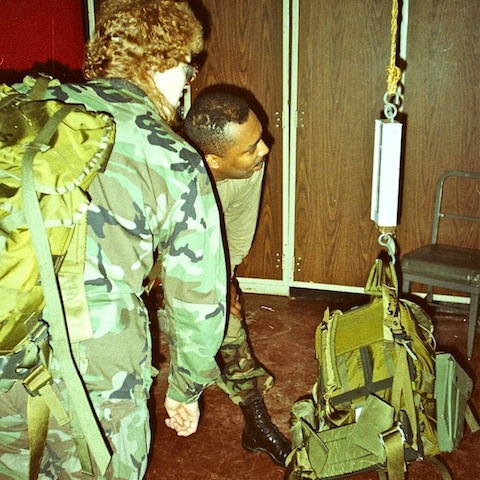Moving Out: To Bragg and Beyond
Ft. Bragg, NC—Besides the weather, unit members found another factor of activation that required coping and “flexibility” in the broadest sense: validation. Validation was a plan — or a plot, depending on whether you were a validator or a validatee — that was developed to bring the performance of the 432nd up to the standards set for becoming Special Operations Forces qualified. This meant that members would be required not just to pass, but to exceed Army-wide standards on the Army Physical Fitness Test as well as the Common Task Test. Validation and cold wet weather seemed just made for one another. As it turned out, the unit’s members pumped out their extra push ups and sit ups and came up with better than average answers to questions about claymore mines and land navigation, winning the distinction of wearing the airborne shoulder patch.
Although validation may have been the overriding concern of the authorities at Ft. Bragg, there were a host of other ongoing events large and small which unit members will long remember such as inprocessing. Inprocessing is a term which sounds innocent enough, but when the process began covering pay policies, wills and beneficiaries, as well as shots for protection against exotic diseases, the process took on some of the traits of medieval torture¹. When the process included a ten kilometer march with a 55 lb. back pack, the torture became even more real². This was an element of validation which generated not paperwork, but blisters, bruises and muscle pains in places never before imagined.

Middle: Me (asleep), Steve Dutch, unknown
Back: Matt Fellinger
Far less painful but equally memorable were some other experiences which added flavor to the unit’s stay at Bragg. There was, for example, the policy of assigning a variety of NCO’s the job of PT instructor. Each instructor had their own style for calisthenics, with SPC June Williams, perhaps winning recognition as the most favored of the instructors, except possibly for “Jeannie,” whose aerobics leadership was also unforgettable.
The time at Bragg will also be remembered for such things as PX trips, high & tight haircuts, long lines at the telephone booths, long walks to the orderly room,jody calls to add class to marching and jogging. There were also classes to equip members with everything from survival Arabic to coping with Arab culture.
McMurry’s Notes
- We got the shots the afternoon before the PT test. Some people got as many as six shots. I got four. The next morning the temperature was below freezing, the wind was whipping and it was raining, snowing and sleeting all at once. It was the worst weather I’ve ever done PT in. To make matters worse, I was sick from the shots and my arms were so sore I could not raise them above my waist. Needless to say, I failed the test. As did about half the rest of the unit.
Nonetheless, the higher standard on the PT test was not all it was cracked up to be. Some people never did pass it, even at the normal standard. Some could not meet the height/weight standards. One captain was at least 80 pounds overweight. (Since he figures prominently in future notes, I’ll call him CPT Stout.) They still went. The Army needed bodies that badly. This goes to prove my contention that as it is currently formatted the PT test has no correlation to mission performance.
- I started out too fast. Shot right to the front of the pack, then faded about the half way point. CPT Deb Luebker beat 99% of the men and SP4 Jim Nicholson’s grit and determination were awe-inspiring. (He crawled out his sick bed and staggered across the finish line with dehydration and a 104 degree fever.)

CPT Deb Luebker weighing her ruck.
| Page 1 | Page 2 | Page 3 |
